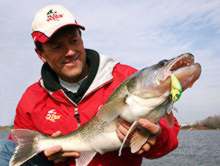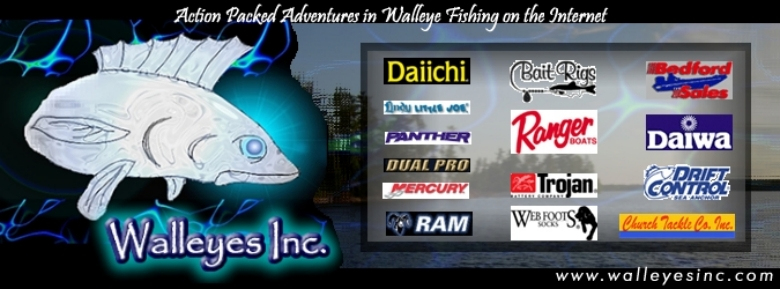There are general rules of thumb to follow while fishing.
Some areas are good each spring and some patterns emerge like
clockwork. Early in the season, you can often find walleye
in shallow water on many lakes and reservoirs… that
might be a general rule of thumb, a starting point. Another
starting point might be the back end of bays and creek arms.
Some patterns and locations click when everything goes according
to plan. If we were to play the odds, these shallow and warmer
locations are going to hold fish most of the time. Other factors
emerge as well. Gravel or rock might attract spawning fish
for example and the males might hang around these areas for
much longer. Fishing pressure might also throw an interesting
twist to fish location in the sense that these obvious locations
where you know there are fish get a serious amount of attention.
When we often picture patterns and locations for catching
walleye, we often also picture traditional and stable weather
patterns.
 |
Weird weather, storm fronts, wicked winds
and the like can throw everything you think you know right
out the window. There are times where fish aren’t
going to be where they were last spring or the last five
springs and the culprit is usually related to weather
There has been a lot written and said about walleye being
shallow whenever the wind is pounding a shoreline or where
wind has muddied the water. There has been a lot said
about walleye being shallow or feeding aggressively whenever
there are overcast skies |
Many people have a mindset that the fishing early in the
season gets good or better with some kind of weather. Clouds
and wind are supposed to make walleye bite better right? From
my own experiences on primarily large natural lakes and reservoirs,
these conditions often coincide with drops in air and water
temperature. These types of conditions generally ruin the
traditional patterns not make them better.
For many anglers, trolling crankbaits early in the season
is almost taboo. There are obviously strong trolling bites
happening on some of the Great Lakes and river systems early
in the season but many anglers have a hard time trolling crankbaits
on many lakes and reservoirs right away. The truth is, presenting
live bait in less than ten feet of water is probably going
to work better most of the time but… for those times
when nothing is working where it should crankbaits often save
the day.
Storm fronts and nasty winds can change fish location so
quickly and usually from what I have found, these fish usually
move deeper. I often use other fish as well to serve as a
barometer. If for example I am catching walleye in four feet
of water for argument sake and mixed in with walleye are drum,
white bass, pike, etc these other fish give me clues as well.
If I am still catching these same fish after some sort of
change in the environment, I know not to go off the deep end
too far with location. If however I completely blank where
I think I should be catching walleye and don’t get bites
from anything, I know the change is much more serious. Also,
say I slide out to thirty feet of water and start picking
up white bass as an example when really, white bass shouldn’t
be there… I know I am getting close again.
Most of the time early in the season, every fish in the lake
should be shallow. When you get blanked up shallow and start
hitting fish regardless of species in much deeper water, you
now know that whatever factors sent these other fish off the
traditional patterns are probably also changing the walleye’s
routine.
Trolling enables me to cover a wide range of depths and several
acres of water in a hurry. Lead core line enables me to put
the subtle tight wobbling crankbaits that work so well in
cold water to any depth I need to fish. Generally, trolling
speeds are much slower in the spring than during summer or
fall. Often, 2 miles per hour ground speed on the GPS is the
high end for speed but even 1.2 to 1.6 miles per hour is significant
for covering water, much faster than most live bait presentations.
To control and fine tune-trolling speeds while slowly crawling
with lead core and crankbaits, a drift control sock is an
essential tool for boat control. Throwing off just one small
drift sock off the front cleat of the boat is going to drop
your speed down. Putting down your bow mount trolling motor
down as well will generally drop your ground speed by .2 miles
per hour. Angling into the wind or chop or even hitting the
waves sideways will also drop your speed even more. During
severe wind where you have to troll with the wind to control
the boat and keep planer boards from snapping and bogging
down, two drift socks might be necessary. A drift sock off
each side of the boat will enable to stay on course and turn
much easier with heavier seas.
Early in the season, the surges and jerks on the lure that
might work so well to trigger fish later in the year can sometimes
be a negative. Some stops or stalls are usually good but the
lure still has to be easy to catch. This is one of the few
times where I will let out too much lead core and let the
line really bow in the water and slap bottom. The extra bow
in the line when moving at extremely slow speeds seems to
absorb some of the wild surges that occur when trolling through
big waves. I also seem to have better luck by using a longer
leader than normal. I don't think the long leader is the result
of fish being line shy but perhaps subdues the action in some
way. I also like to use Fireline for the leader because short
hits and shake offs that just reveal a fish for even a second
are easier to notice. Even if the fish barely nips the crank
and shakes off with one headshake, I still want to know about
that as this information allows me to make better decisions.
Short hits are often the rule as well in the sense that fish
are often hooked with the back hooks on the crankbait…
often just one hook in the tip of the walleye’s jaw.
Where and how the fish are getting hooked on crankbaits tells
you a lot about how these fish are hitting. Lures that are
caught sideways in the fish’s mouth or swallowed are
revealing that the fish are generally hitting these lures
pretty aggressively. Fish that are stuck on the outside of
the face or barely through the front of the mouth with one
hook reveal that these fish aren’t overly aggressive.
If I can get to the rod immediately or am holding the rod,
I will often give the rod a little bit of a hook set when
trolling at these ultra low speeds. I have also found that
I am much more successful landing fish by keeping the drags
set really light as these fish will come unbuttoned if you
horse them. Many of the fish shake off in the net. A long
handled trolling net is a big plus. When Lindy Legendary Tackle
bought Beckmen Nets, they sent me a trolling net with an extremely
long handle. That handle must extend out to twelve feet or
more and might seem kind of awkward but boy has that net saved
me some fish. Now I can’t imagine trolling without it.
When trolling at these slow speeds during the spring, I will
sometimes kick my speed up just a hair as well after hooking
up with a fish that I really want to get. Whenever possible,
I want the fish to ski or rise up behind the boat versus digging
and running below the motor especially when barely hooked.
Also when I can see the fish coming to the surface behind
the boat, I can tell how the fish is hooked which allows me
to make better decisions on how much pressure I can use to
land the fish.
This past season, I had the opportunity to design what I
feel is the perfect trolling rod (Jason Mitchell Guide Series
Rods). The rod has a soft forgiving tip, which enables anglers
to get those lightly hooked fish into the net. The rod also
differs from many other trolling rods in the sense that we
shortened the butt of the rod so the movement on the rod tip
while removing the rod from the rod holder is more fluid.
This is a big aid when trying to maintain the right amount
of pressure on lightly hooked fish without giving any slack.
These trolling rods also fish longer in the sense that the
overall rod length isn’t tied up in a long handle that
gets in the way inside the boat.
When fish aren’t where they should be this spring,
trolling areas nearby and deeper will often put you on the
pattern again. Especially during abnormal or abrupt weather
patterns, we often find walleye scattered off the first significant
break and across the first significant flat that is located
where the fish were or should be. Many people also assume
that the weather that can shut fishing down will put these
fish on sharp breaks and to the sides of structure. This might
be the case at times but the adjacent deeper flats or basins
that run along these breaks often hold a significant number
of fish as well and these areas are much easier to cover in
a hurry by trolling crankbaits.
Editors Note: The author, Jason Mitchell is a legendary guide
on North Dakota’s Devils Lake. This article has been
brought to you by Jason Mitchell Guide Series Rods, www.jasonmitchellrods.com.
|

